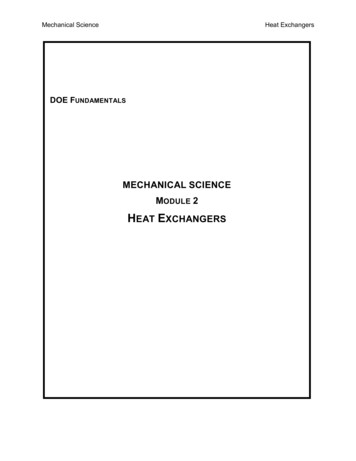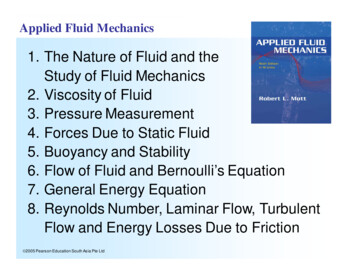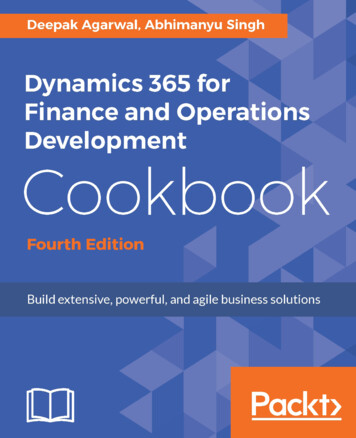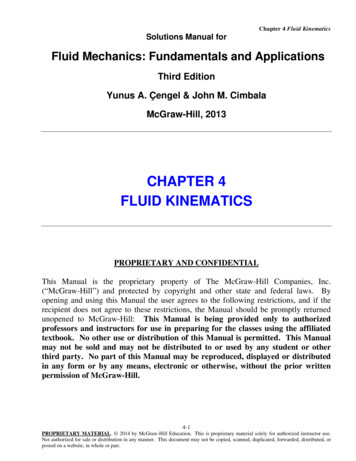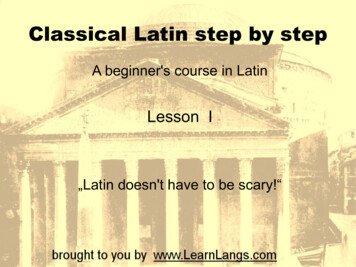
Transcription
Topics in Fluid Dynamics:Classical physics and recent mathematicsToan T. Nguyen1,2Penn State UniversityGraduate Student Seminar @ PSUJan 18th, 201812Homepage: http://math.psu.edu/nguyenMath blog: https://sites.psu.edu/nguyenToan T. Nguyen (Penn State)Fluid DynamicsPSU, Jan 18th, 20181 / 20
Fluid motionxtu(x, t)ΩΩFigure: Fluid domain: Ω R3 and unknown fluid trajectory: xt Ω (left) orunknown fluid velocity: u(x, t) R3 (right).Toan T. Nguyen (Penn State)Fluid DynamicsPSU, Jan 18th, 20182 / 20
Fluid motionxtu(x, t)ΩΩFigure: Fluid domain: Ω R3 and unknown fluid trajectory: xt Ω (left) orunknown fluid velocity: u(x, t) R3 (right). Lagrangian description (left): trajectory of each fluid molecule x Ωẋt u(xt , t),Toan T. Nguyen (Penn State)Fluid Dynamicsx0 xPSU, Jan 18th, 20182 / 20
Fluid motionxtu(x, t)ΩΩFigure: Fluid domain: Ω R3 and unknown fluid trajectory: xt Ω (left) orunknown fluid velocity: u(x, t) R3 (right). Lagrangian description (left): trajectory of each fluid molecule x Ωẋt u(xt , t),x0 x Eulerian description (right): velocity fieldu(x, t) R3at each position x Ω and time t 0.Toan T. Nguyen (Penn State)Fluid DynamicsPSU, Jan 18th, 20182 / 20
Fluid motionClassical fluid dynamics:Continuum Hypothesis: Each point in Ω corresponds to a fluidmolecule (e.g., Hilbert’s 6th open problem: continuum limit fromN-particle system3 ).3see my lecture notes on Kinetic Theory of Gases: https://nttoan81.wordpress.comToan T. Nguyen (Penn State)Fluid DynamicsPSU, Jan 18th, 20183 / 20
Fluid motionClassical fluid dynamics:Continuum Hypothesis: Each point in Ω corresponds to a fluidmolecule (e.g., Hilbert’s 6th open problem: continuum limit fromN-particle system3 ).Continuity equation: along particle trajectory, mass remains constant:ρ(xt , t) det( x xt )dx ρ(x, 0)dxxtρdyxρdxFigure: Illustrated the Lagrangian map: x 7 xt for each t 6 0.3see my lecture notes on Kinetic Theory of Gases: https://nttoan81.wordpress.comToan T. Nguyen (Penn State)Fluid DynamicsPSU, Jan 18th, 20183 / 20
Fluid motionIncompressibility:4 volume preserving flows iff ·u 0(Exercise:4ddt J ( · u)J). x1 u1 x2 u2 0water can be modeled by an incompressible flow, but air is compressible.Toan T. Nguyen (Penn State)Fluid DynamicsPSU, Jan 18th, 20184 / 20
Fluid motionIncompressibility:4 volume preserving flows iff ·u 0(Exercise:ddt J ( · u)J). x1 u1 x2 u2 0In particular, fluid density ρ(x, t) remains constant along the flow. Inwhat follows, ρ 1 (continuity equation incompressibility).zuuθFigure: Illustrated shear flows (left) and circular flows (right), both areincompressible.4water can be modeled by an incompressible flow, but air is compressible.Toan T. Nguyen (Penn State)Fluid DynamicsPSU, Jan 18th, 20184 / 20
Fluid motion Momentum equation: Newton’s law: F ma or equivalently,Dt u FwithDt : t u · with F being force acting on fluid parcel:Toan T. Nguyen (Penn State)Fluid DynamicsPSU, Jan 18th, 20185 / 20
Fluid motion Momentum equation: Newton’s law: F ma or equivalently,Dt u FwithDt : t u · with F being force acting on fluid parcel:No force: F 0. Free particles satisfy Burgers equation (nonphysical:no particle interaction):tuxx1x2xFigure: Smooth solutions blow up in finite time (see, of course, the theory ofentropy shock solutions: Bressan, Dafermos)Toan T. Nguyen (Penn State)Fluid DynamicsPSU, Jan 18th, 20185 / 20
Euler equations“Ideal” fluid:5 F p, pressing normally inward on the fluidsurface (called pressure gradient):Zp ndσ(x)F O O5as opposed to viscous fluid.Toan T. Nguyen (Penn State)Fluid DynamicsPSU, Jan 18th, 20186 / 20
Euler equations“Ideal” fluid:5 F p, pressing normally inward on the fluidsurface (called pressure gradient):Zp ndσ(x)F O OThis yields Euler equations (1757, very classical):Dt u p ·u 0posed on Ω R3 with u · n 0 on Ω. NOTE: 4 equations and 4unknowns: u, p.5as opposed to viscous fluid.Toan T. Nguyen (Penn State)Fluid DynamicsPSU, Jan 18th, 20186 / 20
Euler equationsz Examples (stationary):Laminar flows (shear or circular flows):U(z)u for arbitrary U(z)0with zero pressure gradient.6UCouette flow: U(z) zFigure: internetToan T. Nguyen (Penn State)Fluid DynamicsPSU, Jan 18th, 20187 / 20
Euler equationsz Examples (stationary):Laminar flows (shear or circular flows):U(z)u for arbitrary U(z)0with zero pressure gradient.UCouette flow: U(z) zPotential flows: u φ and so φ is harmonic: φ 0(incompressible, irrotational flows)Streamlines of potential flows66Figure: internetToan T. Nguyen (Penn State)Fluid DynamicsPSU, Jan 18th, 20187 / 20
Euler equations Vorticity: to measure the rotation in fluidsω u(anti-symmetric part of u, recalling ẋ u u0 ( u0 )x: translation,dilation, and rotation).Toan T. Nguyen (Penn State)Fluid DynamicsPSU, Jan 18th, 20188 / 20
Euler equations Vorticity: to measure the rotation in fluidsω u(anti-symmetric part of u, recalling ẋ u u0 ( u0 )x: translation,dilation, and rotation).Note that ω̇ [ω, u] (the Lie bracket), or explicitlyDt ω ω · uToan T. Nguyen (Penn State)Fluid DynamicsPSU, Jan 18th, 20188 / 20
Euler equations Vorticity: to measure the rotation in fluidsω u(anti-symmetric part of u, recalling ẋ u u0 ( u0 )x: translation,dilation, and rotation).Note that ω̇ [ω, u] (the Lie bracket), or explicitlyDt ω ω · uTheorem (Helmholtz’s vorticity law)t ω (x).Vorticity moves with the flow: ω(x, t) x#0(as a consequence, vortex remains a vortex).Hint: Computeddt (ωToan T. Nguyen (Penn State)t ω (x)). x#0Fluid DynamicsPSU, Jan 18th, 20188 / 20
Euler equationsuγtStTheorem (Kelvin’s circulation theorem)Vorticity flux through an oriented surface or circulation around an orientedcurve is invariant under the flow:IZZΓγ u · ds ω · dSγSHint: A direct computation.Toan T. Nguyen (Penn State)Fluid DynamicsPSU, Jan 18th, 20189 / 20
Euler equations3D Euler:Dt ω ω · u Vortex stretching: ω · u, which appears “quadratic” in ω, and oneddcould end up with dtω ω 2 or even dtω ω 1 , whose solutions blow upin finite time. However,Toan T. Nguyen (Penn State)Fluid DynamicsPSU, Jan 18th, 201810 / 20
Euler equations3D Euler:Dt ω ω · u Vortex stretching: ω · u, which appears “quadratic” in ω, and oneddcould end up with dtω ω 2 or even dtω ω 1 , whose solutions blow upin finite time. However, Open problem: do smooth solutions to 3D Euler actually blow up infinite time? (no, if vorticity remains bounded, Beale-Kato-Majda ’84).Toan T. Nguyen (Penn State)Fluid DynamicsPSU, Jan 18th, 201810 / 20
Euler equations3D Euler:Dt ω ω · u Vortex stretching: ω · u, which appears “quadratic” in ω, and oneddcould end up with dtω ω 2 or even dtω ω 1 , whose solutions blow upin finite time. However, Open problem: do smooth solutions to 3D Euler actually blow up infinite time? (no, if vorticity remains bounded, Beale-Kato-Majda ’84). Recent mathematics and then a proof of Onsager’s conjecture ’49: Isett,De Lellis, Székelyhidi, Buckmaster, Vicol,. Numerical proof of finite timeblow up: Luo-Hou, Sverak,.Toan T. Nguyen (Penn State)Fluid DynamicsPSU, Jan 18th, 201810 / 20
2D Euler equations In fact, many physical fluid flows are essentially 2D:Atmospheric and oceanic flowsFlows subject to a strong magnetic field, rotation, or stratification.Toan T. Nguyen (Penn State)Fluid DynamicsPSU, Jan 18th, 201811 / 20
2D Euler equations In fact, many physical fluid flows are essentially 2D:Atmospheric and oceanic flowsFlows subject to a strong magnetic field, rotation, or stratification. In 2D, vorticity is scalar and is transported by the flow:Dt ω 0(no vortex stretching). In particular, vorticity remains bounded, smoothsolutions remain smooth, and weak solutions with bounded vorticity areunique (Yudovich ’63).Toan T. Nguyen (Penn State)Fluid DynamicsPSU, Jan 18th, 201811 / 20
2D Euler equations An important problem: the large time dynamics of 2D Euler. Complete mixing: whether ω(tj ) * 0 in L , as tj ? No, due to energyconservation. However,Toan T. Nguyen (Penn State)Fluid DynamicsPSU, Jan 18th, 201812 / 20
2D Euler equations An important problem: the large time dynamics of 2D Euler. Complete mixing: whether ω(tj ) * 0 in L , as tj ? No, due to energyconservation. However,Conjecture (2D inverse energy cascade, Kraichnan ’67)Unlike 3D, energy transfers to larger and larger scales (low frequencies).Figure: Source: van Gogh and internetToan T. Nguyen (Penn State)Fluid DynamicsPSU, Jan 18th, 201812 / 20
2D Euler equations 2D Euler steady states:u0 · ω0 0With u0 φ0 , the stream function φ0 and vorticity ω0 have parallelgradient, hence (locally) ω0 F (φ0 ), yielding φ0 F (φ0 )Toan T. Nguyen (Penn State)Fluid DynamicsPSU, Jan 18th, 201813 / 20
2D Euler equations 2D Euler steady states:u0 · ω0 0With u0 φ0 , the stream function φ0 and vorticity ω0 have parallelgradient, hence (locally) ω0 F (φ0 ), yielding φ0 F (φ0 ) Major open problem: which F determines the large time dynamics ofEuler?Toan T. Nguyen (Penn State)Fluid DynamicsPSU, Jan 18th, 201813 / 20
2D Euler equations 2D Euler steady states:u0 · ω0 0With u0 φ0 , the stream function φ0 and vorticity ω0 have parallelgradient, hence (locally) ω0 F (φ0 ), yielding φ0 F (φ0 ) Major open problem: which F determines the large time dynamics ofEuler?Theorem (Arnold ’65)If F is strictly convex, then steady states u0 are nonlinearly stable in H 1 .Hint: Find casimir functional so that u0 is a critical point.Toan T. Nguyen (Penn State)Fluid DynamicsPSU, Jan 18th, 201813 / 20
2D Euler equations A delicate question: whether Arnold stability implies asymptotic stability(recalling Euler is an Hamiltonian)?Toan T. Nguyen (Penn State)Fluid DynamicsPSU, Jan 18th, 201814 / 20
2D Euler equations A delicate question: whether Arnold stability implies asymptotic stability(recalling Euler is an Hamiltonian)?Inviscid damping: Kelvin 1887, Orr 1907Mathematics near Couette: Masmoudi, Bedrossian, Germain ’14zuToan T. Nguyen (Penn State)Fluid DynamicsPSU, Jan 18th, 201814 / 20
2D Euler equations Hydrodynamic stability: Rayleigh, Kelvin, Orr, Sommerfeld,Heisenberg,.the study of spectrum of shear flows: U(z)u 0U 0ZUU 0Toan T. Nguyen (Penn State)Fluid DynamicsPSU, Jan 18th, 201815 / 20
2D Euler equations Hydrodynamic stability: Rayleigh, Kelvin, Orr, Sommerfeld,Heisenberg,.the study of spectrum of shear flows: U(z)u 0U 0ZUU 0Rayleigh (1880): U(z) that has no inflection point is spectrally stable.Toan T. Nguyen (Penn State)Fluid DynamicsPSU, Jan 18th, 201815 / 20
2D Euler equations Hydrodynamic stability: Rayleigh, Kelvin, Orr, Sommerfeld,Heisenberg,.the study of spectrum of shear flows: U(z)u 0U 0ZUU 0Rayleigh (1880): U(z) that has no inflection point is spectrally stable.?Figure: Great interest in the early of 20th century (aerodynamics). Source:internetToan T. Nguyen (Penn State)Fluid DynamicsPSU, Jan 18th, 201815 / 20
2D Navier-Stokes equations Viscous fluid: F p ν u (Newtonian), with fluid viscosity ν 0:( t u · )u p ν u ·u 0posed on Ω R3 with u 0 on Ω. NOTE: u, p are unknown.Toan T. Nguyen (Penn State)Fluid DynamicsPSU, Jan 18th, 201816 / 20
2D Navier-Stokes equations Viscous fluid: F p ν u (Newtonian), with fluid viscosity ν 0:( t u · )u p ν u ·u 0posed on Ω R3 with u 0 on Ω. NOTE: u, p are unknown. Million-dollar open problem: whether smooth solutions to 3D NavierStokes blow up in finite time. (Like 2D Euler, smooth solutions to 2DNavier Stokes remain smooth, Ladyzhenskaya ’60s).Toan T. Nguyen (Penn State)Fluid DynamicsPSU, Jan 18th, 201816 / 20
2D Navier-Stokes equations Viscous fluid: F p ν u (Newtonian), with fluid viscosity ν 0:( t u · )u p ν u ·u 0posed on Ω R3 with u 0 on Ω. NOTE: u, p are unknown. Million-dollar open problem: whether smooth solutions to 3D NavierStokes blow up in finite time. (Like 2D Euler, smooth solutions to 2DNavier Stokes remain smooth, Ladyzhenskaya ’60s). .back to Hydrodynamic Stability.Toan T. Nguyen (Penn State)Fluid DynamicsPSU, Jan 18th, 201816 / 20
2D Navier-Stokes equationsThe role of viscosity:d’Alembert’s paradox, 1752: Zero drag exerted on a body immersedin a potential flow (as momentum equation is in the divergence form).Birds can’t fly!L. Prandtl, 1904: the birth of the boundary layer theory (viscousforces become significant near the boundary). This gave birth ofAerodynamics.Toan T. Nguyen (Penn State)Fluid DynamicsPSU, Jan 18th, 201817 / 20
2D Navier-Stokes equationsThe role of viscosity, cont’d:Lord Rayleigh, 1880: “Viscosity may or may not destabilize the flow”Reynolds experiment, 1885: All laminar flows become turbulent at ahigh Reynolds number:Re : inertial forceviscous forceToan T. Nguyen (Penn State) u · uν uFluid Dynamics ULν&104PSU, Jan 18th, 201818 / 20
2D Navier-Stokes equationsRecent mathematics:7 Grenier (ENS Lyon)-Toan 2017-:Confirming the viscous destabilization (linear part with Y. Guo)Invalidating generic Prandtl’s boundary layer expansionDisproving the Prandtl’s boundary layer Ansatz7for more, see my blog: https://nttoan81.wordpress.comToan T. Nguyen (Penn State)Fluid DynamicsPSU, Jan 18th, 201819 / 20
2D Navier-Stokes equationsPerspectives: Boundary layer cascades, bifurcation theory, stability of rollwaves, fluid mixing, and much more!yu Euler1ν 2 : Prandtl’s layer3ν 4 : 1st sublayer5ν 8 : 2nd sublayer···ν: Kato’s layerxToan T. Nguyen (Penn State)Fluid DynamicsPSU, Jan 18th, 201820 / 20
Vortex stretching: !ru, which appears \quadratic" in !, and one could end up with d dt!ˇ!2 or even d dt!ˇ!1 , whose solutions blow up in nite time. However, Open problem:do smooth solutions to 3D Euler actually blow up in nite time? (no, if vorticity remains bounded, Beale-Kato-Majda '84).

